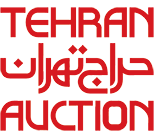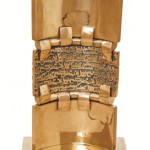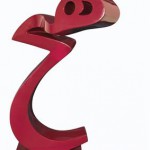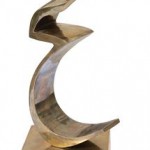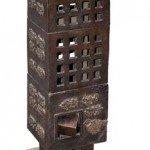In his historic relief, Parviz Tanavoli is demonstrating a heritage that it took him a lifetime to discover and give life to. He presents symbols such as padlock and key as well as metal fasteners and networks in his composition to achieve visual proportion, and appropriate the immortal heritage of age-old Iranian industries; a precious heritage that shapes a good portion of Iranian industrial art spanning pre-historic era to Islamic period.
Such visual symbols in Tanavoli’s work of decades have given it an identity and character. In this copper relief of 1968, only a few years after the Iranian school of Saqqakhaneh emerged, familiar elements similar to usual padlocks and keys of the artist are seen, shaping the composition of the work in a formal connection. His name also appears in a section of the work beside the forms inspired by Iranian Modernism.
In different periods of his career, Parviz Tanavoli never abandoned Iranian traditional elements that had been an achievement of Saqqakhaneh School of art. He had a driving force behind artistic manipulation of padlocks and keys even before the school emerged; before he was fascinated by forsaken Iranian art forms. Tanavoli writes about it, “I had a fascination with padlocks as a child. I would spend hours trying to fix a broken padlock whenever I came across one. Our house had a bathroom which would not be used. I gradually turned it into a storage room for my stuff that included all sorts of spikes, nails, wooden objects, padlocks and keys. I would collect disposable objects and spend most of the time with my tools and belongings in the storage room. One of the things that could take me out of home and onto the street was the voice of locksmith. They would pass by hawking for people who needed their padlock fixed.”
Such challenges gradually developed roots in Tanavoli, until in early 1960s, he invented Saqqakhaneh School along with like-minded artists. The entire achievements of this school of thought have roots in beliefs and thoughts that introduced Iran’s young, modern art to an indigenous style. At a historic point in time, a one-day trip to the shrine of Shah Abdul Azim of Parviz Tanavoli along with Hossein Zenderoudi marked the development of a huge, immortal achievement in Iranian modern art.
In general, Tanavoli’s reliefs are median works between his paintings and multifaceted free sculptures that, in addition to a similar formal structure, carry well-known motifs in their narratives. In addition to the visual sense, Tanavoli sets out to stimulate the tactile sense of his audience by producing such motifs so that other than gaining visual enjoyment, a set of other senses as well as historical perception of the audience will also be engaged.
In expressing and discovering history, Tanavoli sometimes produces sculpture and relief and at times practices painting. Roots of beliefs, thoughts, and concerns of the artist can be traced in the age-old stories of this land, expressed in a present-day language and in a different medium in his work.
The present relief expresses, in a modern language, spirit of the time and historic motifs of a land that the artist adores. Through his engravings on metal surfaces, Tanavoli is, in fact, expressing the essence of original spirit of Iranian art in a unique language.
He is among the modernist masters of Iranian art who has always played a determining role in domestic and international art markets. As a result of a lifetime achievement, one of Tanavoli’s sculptures titled Persepolis was sold for more than $2.8 million at Christie’s auction in 2008, setting a record in the Middle East. At least two other works of the artist worth more than $1 million were sold later. It must be noted that a similar, but smaller, relief was sold for nearly $100,000 at Christi’s Dubai auction, 2010
